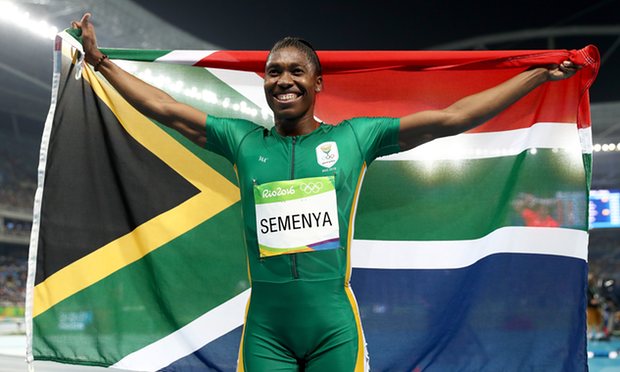



Caster Semenya celebrates her 800m Olympic final gold medal run. Photograph: Ezra Shaw/Getty Images
AFTER Caster Semenya crossed the finish line, she flexed her biceps and pretended to brush the dust from her shoulders. She looked one proud woman.
Semenya won the Olympic 800m in a time of 1min 55.28sec, a personal best, a South African national record, and the fastest time in the world this year. Still, though, a full two seconds short of the world record set by Jarmila Kratochvilova back in 1983.
Behind her came Burundi’s Francine Niyonsaba and Kenya’s Margaret Wambui. And the unpleasant truth is that while neither of those athletes has identified themselves as being hyperandrogenic, in recent days both have been subjected to the very same innuendos which once surrounded Semenya herself, before she was outed by the IAAF in 2009.
At London 2012, Semenya won the silver in 1min 57.23sec, just under two seconds slower than her time here. Back then she was taking hormones to surpress her naturally high testesterone levels, as the IAAF insisted she must do if she wanted to continue to compete.
The legality of that rule was challenged by another hyperandrogenic athlete, Indian sprinter Duttee Chand, at the Court of Arbitration for Sport in 2015. Chand claimed she was being discriminated against. And CAS agreed, in so much as they ordered the IAAF to suspend the testosterone eligibility rule and gave them two years to gather and present more evidence demonstrating exactly how much of an advantage hyperandrogenic competitors had over everyone else.
Two hours before the 800m final started, IAAF President Seb Coe reiterated that they would be taking the case back to CAS, and in doing so he made it clear that he believes Semenya and all other hyperandrogenic athletes do have an unfair advantage which would need to be curbed, most likely by making them take some form of hormone therapy to bring their testosterone down to what the IAAF considers to be more normal levels.
“We will take the case back to CAS,” Coe said, “and it will be a good case, it will be based on medical and scientific advice.”
“This is a complicated medical issue, but I don’t think it is actually a complicated procedure,” Coe said.
“We presented the case for a level of testosterone and a set of protocols, but CAS did not find in our favour about. They set us our homework and sometime between now and next summer we need to return to them.”
Coe stood by his statement from last week, which is unsurprising, given that he was repeating himself. Again, it didn’t seem to occur to him that this might not be the best time and place to talk about all this, or that by doing so he was only increasing the pressure on and scrutiny of Semenya.
“I do not dissent from a word I said, this is a very senstive issue,” Coe said. Hyperandrogenic athletes, he explained, “are sisters and they are daughters” he said, as though this needed stating.
“I have daughters and I know how I would feel if this was being played out in the way that some people have been trying to play it out.”
Which seemed a strange formulation, given the IAAF’s own mismanagment of Semenya’s case, especially at the World Championships in 2009, when she was outed as “intersex”, a label which she never seems to have actually used about herself, but has stuck ever since.
Complicated as the case is, one thing seems very clear. Semenya, and all of South Africa, must be enormously proud of what she has achieved here, competing under a strain quite unlike that experienced by any other athlete at these Games. The race is over, but the debate has a way to run. theguardian.com
Follow us on Twitter on @FingazLive and on Facebook – The Financial Gazette